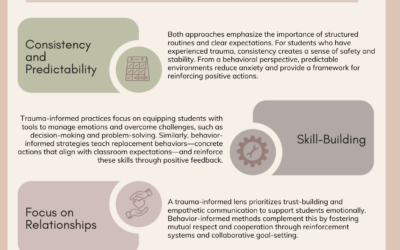How many times have you found yourself stuck in a power struggle with a student and you don’t even know how you got there? All you know is you are stuck, no teaching is happening and everyone is feeling frustrated. Well, it doesn’t have to be like that.
Check out these 10 tricks to never getting into a power struggle again!
1. Ignore what can be ignored in a power struggle
If a behavior isn’t interfering with the learning of others, try to ignore it. (I know it is easier said than done.) Even if it bothers you personally (like pen clicking or tapping), let it go. With some students, the more attention we draw to that behavior, the more problematic it can be.
Sometimes you can decide to ignore behavior “with a plan.” This means that you ignore it in the moment so that you can get through what you need to get through but plan to come back to that behavior when you have time!
2. Let the student get the last word
I know this can be SO hard to do but if you remind yourself that your goal is to be able to teach, and letting a student have the last word allows you to do that, then count it as a WIN!
3. Give the instruction and move on
I know this may sound silly, but it works! Give the student your expectation or direction and then move on. Don’t give the child a chance to talk back to you or tell you they aren’t going to do it. The longer you stay, the more likely they will be to argue.
4. Listen but don’t engage in the student power struggle
Power struggles tend to escalate when both people are engaged in the struggle. It is very hard to maintain a struggle if only one person is in it. 🙂
Sometimes just listening to a student without engaging is enough to de-escalate the situation.
Remember – sometimes a student will talk just to keep you engaged in the struggle so I like think of it as “listening with limits.”
5. Cut your losses
This one hurts. 🙁
I know sometimes it doesn’t feel great to walk away from a situation with a student and feel like we “lost” or are “giving in” but oftentimes that is the right thing to do. I call it “cutting your losses… for now” because even if you walk away or don’t force an issue, you will want to circle back at some point with a plan to make sure you are addressing that issue. Sometimes though, you need to just move on and I am here to tell you that is OKAY!
6. Be Flexible
There is nothing more important when teaching a student that likes to be in control than having flexibility. The minute you dig in, they will dig in ten times more. While you have 100 things that you need to be doing, they may be happy to just sit in the struggle all day. The more flexible you can be in your schedule or expectation, the less likely you will be to fall into a power struggle trap. If something feels like it is taking you into the trap, just be flexible and change directions. While that change may take you a bit off-track, it will likely be less time-consuming than a full-blown power struggle will be.
7. Have plan B ready
I am a huge believer in plan B. When you have a student who tends to engage in power struggles, plan B can be your best friend. A plan B is just a plan for what you will do if things start moving in a direction that you don’t want them to.
You may:
- change the activity
- change the location
- go from non-preferred to preferred
- take a break
- play a game.
All of these are great plan B’s that can turn the tide and stop a power struggle in its tracks.
8. Be willing to compromise
Is there a way to find a middle ground with a student who is engaging in a power struggle? Is there a way to meet them in the middle? If the answer is yes, compromise is a powerful way to de-escalate the situation and get a student back on track to learning.
9. Prioritize-remember what is important
As teachers, we can often get stuck in how we thought things should be or how we planned things to go. Sometimes, just looking at the big picture can help us prioritize what is really important. For example, is the most important issue that the student finishes the worksheet you gave them in the exact way you instructed or is more important that the student is able to show you they understand the concept?
Staying focused on what is really important can help you think outside the box for ways to minimize the struggle and get what you want!
10. Give choices
I put this one last because I have found it such a powerful way to de-escalate a power struggle. Oftentimes, when a student is “stuck” giving them a way out by offering choices is just what they need to turn the corner. Even if it is a simple choice such as “so you want to do this or this first.” it can really minimize the struggle and get things back on track. Add in that if you are looking for more support with dealing with more difficult behaviors such as these, check out Bite-Size Behavior





